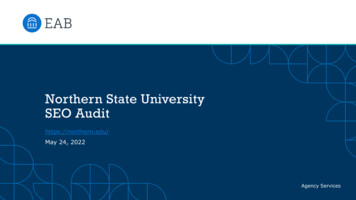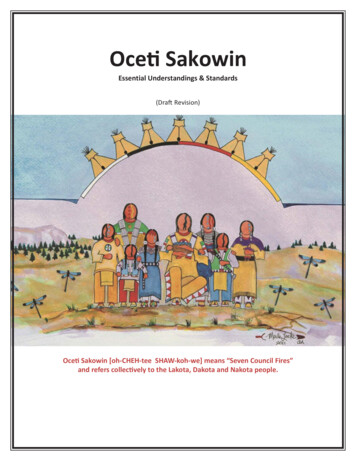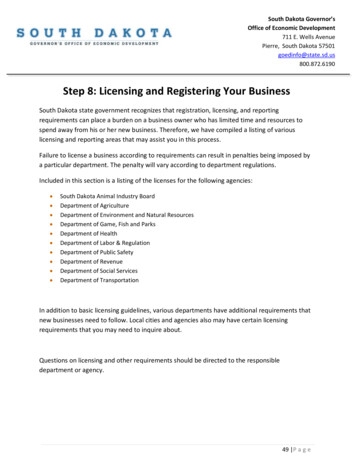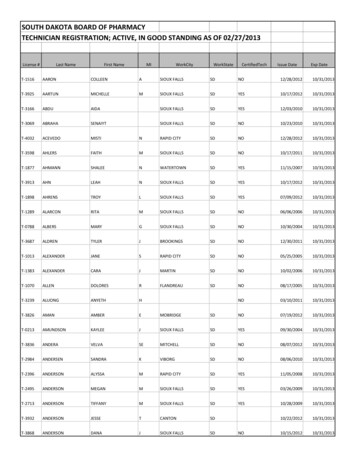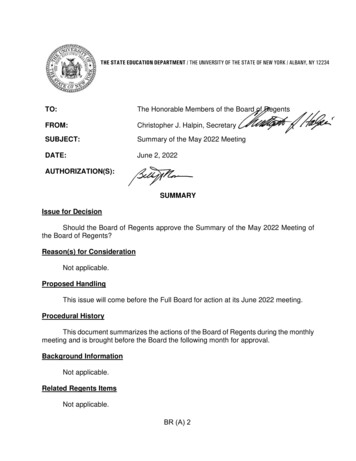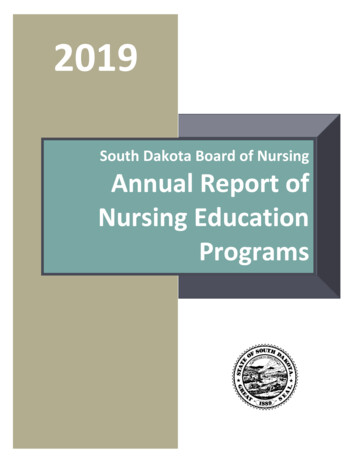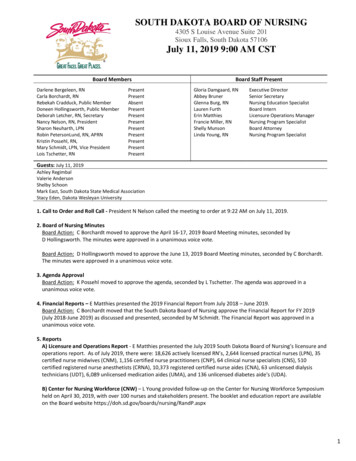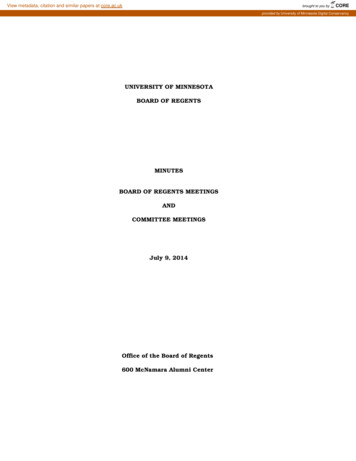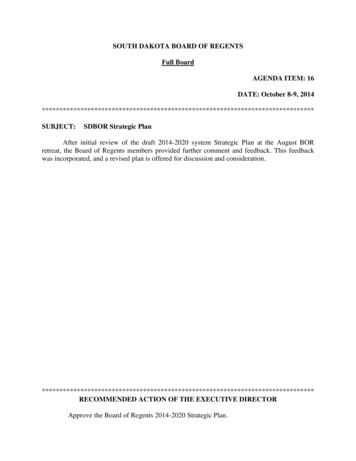
Transcription
SOUTH DAKOTA BOARD OF REGENTSFull BoardAGENDA ITEM: 16DATE: October 8-9, ********************************SUBJECT:SDBOR Strategic PlanAfter initial review of the draft 2014-2020 system Strategic Plan at the August BORretreat, the Board of Regents members provided further comment and feedback. This feedbackwas incorporated, and a revised plan is offered for discussion and DED ACTION OF THE EXECUTIVE DIRECTORApprove the Board of Regents 2014-2020 Strategic Plan.
ATTACHMENT I2South Dakota Board of RegentsStrategic Plan 2014-2020Mission StatementThe Board of Regents’ mission is to provide an excellent, efficient, accessible, equitable andaffordable public university and special schools system that improves South Dakota’s overalleducational attainment and research productivity, while enriching the intellectual, economic,civic, social, and cultural life of the state, its residents, and its communities.A Vision for South DakotaThe public university and special schools system will educate more individuals to higher levelsto enhance state workforce development and will move more research into viable businessesto support state economic development.To align system priorities in a meaningful way, we offer here a sense of the South Dakota thatmight come to exist in the decades ahead: South Dakota’s population will be more highly-educated; South Dakotans will have increased access to continuing education opportunitiesneeded to upgrade their credentials while remaining in the workforce; South Dakota will have a working-age population with advanced levels of educationneeded to support our democracy and the modern, knowledge-based economy; The South Dakota economy will benefit from significant increases in university andassociated research-derived commercialization activities; South Dakota will be a recognized national leader in the use of information technologyto enhance its educational, economic, social, scientific, and political development.Challenges1. According to the 2010 Census, except for the Native American population, thepopulation within South Dakota’s younger-age cohorts is forecast to decline over thenext decade.2. According to the WICHE survey of high school graduates by state, the number of highschool graduates in South Dakota will rise modestly over the coming decade, whilegraduate growth at the regional and national level plateaus. As a result, competition forhigh school graduates in the region will increase, enhancing the need to enroll morenon-traditional students and underserved populations.1
ATTACHMENT I33. Educating Native American students to higher levels will be necessary to improveeducational attainment.4. Increased public investment will be needed to moderate tuition and fee increases andimprove affordable access, especially for lower income students.5. Employee turnover will increase as “Baby Boomers” retire.6. Workforce shortages will increase as skilled job growth exceeds the growth of availableskilled workers.7. Attracting and retaining non-resident students will be even more important in reducingworkforce shortages and will require creative tuition and fee pricing policy.8. Finding academic delivery models that offer enhanced educational quality at a lowercost will be an important strategy in keeping price affordable.9. Flat research spending at the federal level will require diversification and innovation togrow real research and contract spending in South Dakota.10. Strategic investments in higher education’s physical infrastructure will be necessary toallow South Dakota to compete in the modern economy.These challenges lead to a commitment to four major goals that will guide the actions of theBoard of Regents, its system and institutional leaders:1. Student Success – Grow degree production to 7,450 per year by 2020.2. Academic Quality and Performance – Document that academic programs are of thehighest quality.3. Research and Economic Development – Increase annual system research and contractexpenditures to 150M by 2020 to advance knowledge, enhance technology transfer,commercialization, and catalyze economic development.4. Affordability and Accountability – Reduce SD tuition and fees ranking to the regionalaverage by 2020.Goal 1: Student Success – Reflecting rates of growth in total graduates over the last fiveyears, grow degree production to 7,450 per year by 2020.Intended Outcomes: Grow the number of undergraduate and graduate degrees awarded.Increase the number of degrees awarded to Native American students.Improve system first year retention rates.Improve institutional four-year and six-year graduation rates.Reduce the percentage of entering students requiring remediation.2
ATTACHMENT I4Action steps – The role of the Board of Regents is to enact and monitor policy, advocate forstate investment, create incentives to the universities, and monitor and evaluate institutionaloutcomes to achieve the intended outcomes.Expand educational access Create a public engagement campaign to actively promote the value and benefits of auniversity degree.Advocate for increased state funding for need-based aid programs that makepostsecondary education accessible and affordable.Advocate for increased state investment to increase the purchasing power of the SouthDakota Opportunity Scholarship program.Hire a system director of student preparation and success to improve recruitment andsuccess of Native American students.Expand collaborations with Tribal Colleges.Work with the SDDOE to expand dual credit offerings with high schoolsImprove transfer articulation agreements with technical institutes and tribal collegesand universities.Strengthen high school academic preparation by collaborating with SDDOE to improvethe percentage of entering freshmen prepared to perform at the college-level.Encourage campuses to create innovative programs to attract and retain in SD, morenon-resident students.Ensure that special schools’ delivery of outreach services is based on best practice.Seek investment to increase the number of students served by special schools outreachprograms.Work with campuses to improve student retention and completion. Design clearer pathways for degree completion for adult students.Increase the awarding of competency-based credit.Expand alternative approaches to remedial course delivery.Expand degree completion programs for students who have finished a significantnumber of credits, but have not yet graduated.Expand distance learning and hybrid course offerings and improve student supportservices for these students.Encourage campus promotion of completing 15 credit hours per semester.Seek resources to improve career counseling, student support services, and academicsupport and advising.Provide students with better tools to plan and manage their program of study.Work with campuses to expand use of the early alert system.3
ATTACHMENT I 5Seek resources to enhance programs and services for students with disabilities toensure their success, especially those students served by our special schools.Goal 2 - Academic Quality and Performance - Document that academic programs areof the highest quality.The Board of Regents is committed to offering the highest quality academic programs thateducate students broadly through strong Arts and Sciences offerings, coherent generaleducation requirements, and majors and minors that prepare students with the skills andknowledge to thrive in a rapidly changing world.Intended outcomes: Improve the pass rates on licensure and certification exams.Increase the number of accredited programs.Continue to approve new graduate programs.Grow the number of students participating in experiential learning.Action steps1. Program Design and Review – Continually review existing programs for quality, rigor,and relevance in South Dakota’s modern economy. Monitor and refine student learning outcomes for all programs offered. Review general education requirements in the liberal arts and sciences toensure students develop foundational skills, knowledge, and understandingto succeed in the modern world. Revise teacher preparation and educational leadership programs to betterprepare professionals to work in standards-based schools that use the resultsof common assessments for student improvement. Encourage increased professional development for special school outreachworkers and disability specialists. Promote use of instructional delivery models and materials that providehigh-quality instruction and enhanced student learning.2. Accreditation – Support and promote institutional and, where appropriate,programmatic accreditation. Encourage institutions to exceed the criteria for institutional accreditationestablished by the Higher Learning Commission. Encourage institutions to increase the number of academic programs (orspecific colleges or schools within the institutions) that hold programmaticaccreditation. Approve special fees when necessary to provide resources needed foraccreditation.4
ATTACHMENT I63. Student Engagement – Encourage student engagement in research and service. Encourage institutions to grow participation in undergraduate research.Review policies, practices and degree requirements to encourage increasedparticipation in community service, undergraduate research, co-curricularand extra-curricular activities.Goal 3 - Research and Economic Development - Increase annual system research andcontract expenditures to 150M by 2020 to advance knowledge, enhance technologytransfer, commercialization, and catalyze economic development.This goal aligns with 2020 Vision: The South Dakota Science & Innovation Strategy 1 whichprovides a framework for driving research and economic development within the state.Intended Outcomes: Increase grant and contract expenditures.Increase the number of invention disclosures.Increase the number of signed license agreements.Increase the number of licenses signed with start-up companies.Increase the number of graduates from STEM programs.Action steps1. Grant Activity – Support the universities’ efforts to enhance research anddevelopment productivity through grants and contracts in key research sectors,recognizing the mission of each of the Regental universities. Promote physical infrastructure and equipment investments in research areassupporting the following targeted sectors:o Value Added Agriculture and Agribusiness;o Energy and Environment;o Materials and Advanced Manufacturing;o Human Health and Nutrition; ando Information Technology/Cyber-Security/Information Assurance. Assist the universities to increase contract and grant activity in all areas(federal, state, and private), with an emphasis on developing the public andprivate partnerships.1A full copy of the report can be found on the SD EPSCoR website at the following link:http://www.sdepscor.org/ wp-pdf/s&tplan/2020%20Vision.pdf5
ATTACHMENT I72. STEM Education – Expand educational opportunities in the areas of science,technology, engineering, and mathematics. Increase the number of master’s and doctoral level STEM programs.Foster partnerships with K-12 to increase the number of students who cansucceed in STEM programs.Encourage campuses to increase recruitment and retention of undergraduateSTEM majors.3. Economic Development – Contribute to the state’s workforce and economicdevelopment. Encourage development of academic programs and certificates that align withexisting and future state workforce needs. Create incentives for increased numbers of private/public partnerships in keyindustry sectors. Build a robust technology transfer framework within the public universitysystem to foster and promote the commercialization of innovations. Work with research universities to grow research parks to incubate newcompanies and to attract science and technology companies to locate andexpand in South Dakota.1. Goal 4 - Affordability and Accountability - Reduce SD tuition and fees ranking tothe regional average by 2020.Advocate for increased public investment to make higher education affordable for everySouth Dakotan. Manage public higher education to promote transparency and a clearerunderstanding of the costs of higher education.Intended Outcomes: Reduce the three-year federal loan default rate.Move the system’s regional ranking for undergraduate resident tuition and feesfrom 6th best to 4th best.Move student support from 61 percent of operating costs to 50 percent.Reduce education and related spending per degree.Increase the number of students served by the special schools.Action steps1. Streamline academic delivery and support services.6
ATTACHMENT I 8Identify new and innovative ways to deliver high-quality academic courses andprograms that create new markets and reduce cost.Manage unnecessary duplication within academic programs and supportservices.Review and monitor underproductive programs for potential consolidation,elimination or for expected improvements.Monitor program productivity to ensure that available programs align with theinterests of students and the needs of the state.Grow competency-based education.Create incentives in pricing structure that encourage students to earn dualcredits in high school and through AP examinations.Develop improved delivery methods for remedial education that enhancelearning and reduce student costs.Monitor the effectiveness and efficiency of the outsourced contracts at theSchool for the Deaf.2. Manage and control costs passed on to students and increase available support tostudents Produce budget requests that increase state investment over time to increasestate support from the current 39 percent to 50 percent of operating costs andthereby reduce student support from 61 percent to 50 percent.Advocate for increased investment in special schools outreach workers tomaximize support for students with visual and auditory challenges in the schools.Make use of facility utilization reports and enrollment data to target capitalinvestments and manage space.Align system budget requests with the goals and focus of the strategic plan.Commit to an integrated systems approach and shared services where feasible.3. Transparency and Communication – Demystify and simplify public higher educationcosts for students and their families, especially South Dakotans, policymakers, andtaxpayers by making publically available Regental system aggregated data andindividual university data by institution and per student FTE. Provide access to institutional financial statements, outstanding debtinformation, and management reports in a single online location.Create dashboard indicators for key higher education metrics.Provide detail on the resources and revenues that support education, andbenchmark those with other states for the system and for each Regentaluniversity on a per student FTE basis.7
ATTACHMENT I 9Provide detailed enrollment data to allow for tracking of on-campus, off-campus,and distance students.Provide information and the necessary detail so students may better understandthe cost of education and what they are paying for.Communicate the amount of state support available in the base funding of eachuniversity.Provide occupational wage information so students can make informed decisionsabout their selection of majors.4. Alignment – Ensure that special school and higher education institution strategic plansare aligned with the BOR strategic Plan.8
ATTACHMENT II10SDBOR 2020 Strategic PlanSummary of Proposed Performance IndicatorsPriority 1: Student SuccessTotal UG degrees ent(2014) 97mGoal(2020) 3%6th best4th best37 %50%440450260270Total undergraduate degrees awardedTotal GR degrees awardedTotal graduate degrees awardedDegrees awarded to American Indian studentsDegrees awarded to students whose self-reported racial classification is (1) American Indian or Alaska Native alone, or (2)multi-racial including American Indian or Alaska NativeRetention rate, in-systemPercent of first-time, full-time, bachelor’s degree-seeking students returning to any Regental university for a second fallsemesterFour-year graduation rate, at starting institutionPercent of first-time, full-time bachelor’s degree-seeking students graduating in four years or lessSix-year graduation rate, at starting institutionPercent of first-time, full-time bachelor’s degree-seeking students graduating in six years or lessRemediation rate, HSTR entering cohortPercent of first-time, full-time, degree-seeking students from SD high schools who were designated for remedial coursework inat least one subject (math or English)Priority 2: Academic Quality and PerformancePercent passing licensure and certification examsPercent of graduates who were tested and passed a licensure or certification exam in a professional fieldNumber of accredited programsNumber of degree programs with national accreditation or certificationNumber of new graduate programsNumber of new graduate degree programs receiving final approval (per year) from the Board of RegentsStudents participating in experiential learningNumber of students enrolling in at least one internship, practicum, field experience, or cooperative learning experiencePriority 3: Research and Economic DevelopmentGrants and contracts expendituresTotal spending on all federal, state, private, and other grant and contract researchLicense agreementsNumber of signed agreements authorizing a third party to develop university-generated intellectual propertyLicenses signed with start-up companiesNumber of new companies launched that are designed to commercialize university-generated researchSTEM degree majorsNumber of students completing a major in a science, technology, engineering, or mathematics fieldPriority 4: Affordability and AccountabilityThree-year federal student loan default ratePercent of federal student loan borrowers entering repayment in a given fiscal year who default on their loans by the end of thesecond following fiscal yearRegional ranking for UG-R tuition and feesSD’s regional rank for tuition and fees for residential undergraduates at four-year public universities, out of eight regionalneighborsPercent of operating budget funded by the stateCurrent operating support shows 61% coming from students and 37% from the state.Students served by SDSDNumber of students served in any capacity by the SD School for the DeafStudents served by SDSBVINumber of students served in any capacity by the SD School for the Blind and Visually Impaired
Mission Statement The Board of Regents' mission is to provide an excellent, efficient, accessible, equitable and affordable public university and special schools system that improves South Dakota's overall
